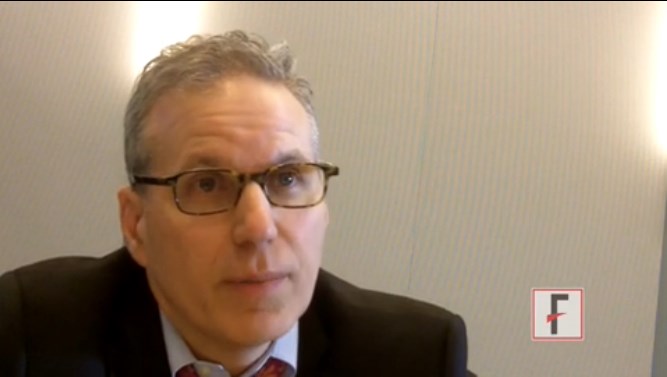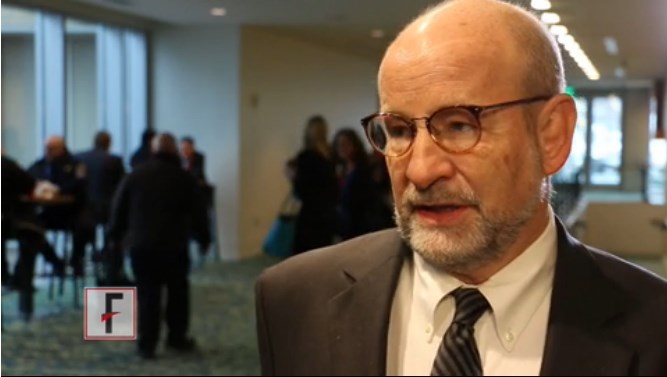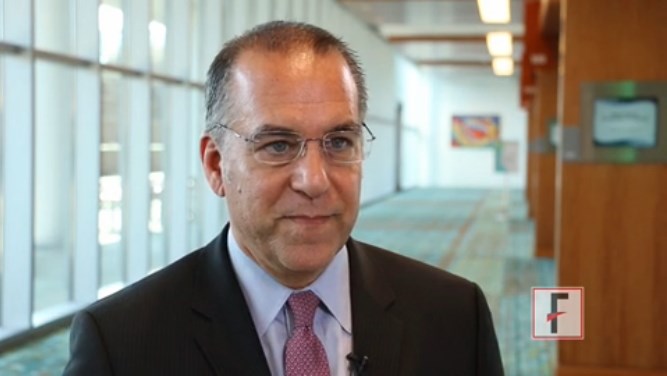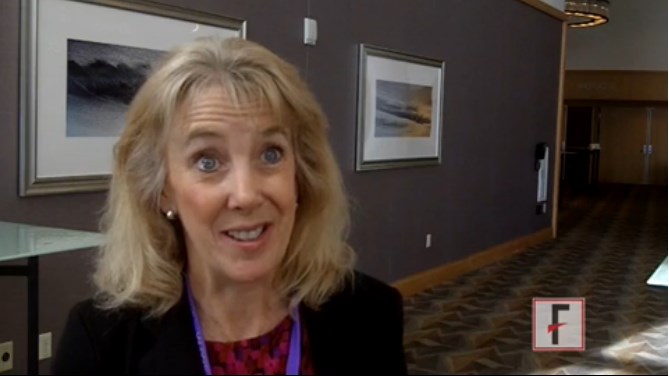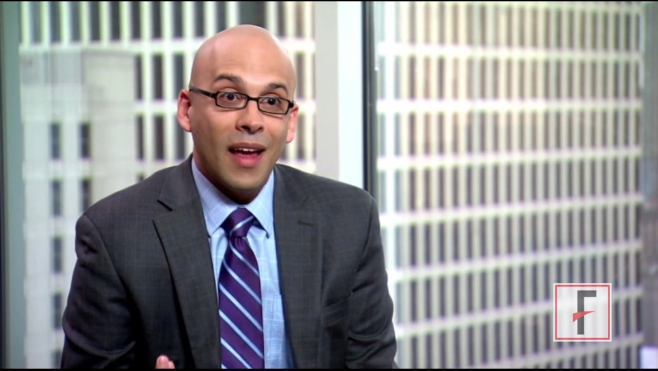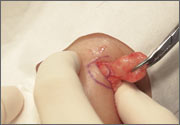User login
VIDEO: Embolectomy’s success in stroke mandates expanded access
NASHVILLE, TENN. – Newly reported results from three trials showing “profound” benefit from endovascular embolectomy in selected patients with acute ischemic stroke “will have a major impact on how we treat stroke patients,” Dr. Lee H. Schwamm said during an interview at the International Stroke Conference.
“Many centers already provide this treatment, but this is the first time we have data on which patients to select” for catheter-based embolectomy, said Dr. Schwamm, professor of neurology at Harvard Medical School and director of acute stroke services at Massachusetts General Hospital in Boston. “Because we already have the capability in many centers, the first focus will be to extend the number of centers that can do this,” Dr. Schwamm noted.
An important part of that will be “changing the public health system to route patients to appropriate facilities” that can perform embolectomy, he said at the conference, sponsored by the American Heart Association.
Dr. Schwamm also noted that intravenous, thrombolytic treatment with tissue plasminogen activator (TPA) remains unchanged as the key first treatment for all patients with acute ischemic stroke. Following that, selected patients who do not fully respond to TPA should proceed to embolectomy. However, the new findings “do not suggest that you should avoid TPA and go directly to the catheter,” Dr. Schwamm cautioned.
The video associated with this article is no longer available on this site. Please view all of our videos on the MDedge YouTube channel
On Twitter @mitchelzoler
NASHVILLE, TENN. – Newly reported results from three trials showing “profound” benefit from endovascular embolectomy in selected patients with acute ischemic stroke “will have a major impact on how we treat stroke patients,” Dr. Lee H. Schwamm said during an interview at the International Stroke Conference.
“Many centers already provide this treatment, but this is the first time we have data on which patients to select” for catheter-based embolectomy, said Dr. Schwamm, professor of neurology at Harvard Medical School and director of acute stroke services at Massachusetts General Hospital in Boston. “Because we already have the capability in many centers, the first focus will be to extend the number of centers that can do this,” Dr. Schwamm noted.
An important part of that will be “changing the public health system to route patients to appropriate facilities” that can perform embolectomy, he said at the conference, sponsored by the American Heart Association.
Dr. Schwamm also noted that intravenous, thrombolytic treatment with tissue plasminogen activator (TPA) remains unchanged as the key first treatment for all patients with acute ischemic stroke. Following that, selected patients who do not fully respond to TPA should proceed to embolectomy. However, the new findings “do not suggest that you should avoid TPA and go directly to the catheter,” Dr. Schwamm cautioned.
The video associated with this article is no longer available on this site. Please view all of our videos on the MDedge YouTube channel
On Twitter @mitchelzoler
NASHVILLE, TENN. – Newly reported results from three trials showing “profound” benefit from endovascular embolectomy in selected patients with acute ischemic stroke “will have a major impact on how we treat stroke patients,” Dr. Lee H. Schwamm said during an interview at the International Stroke Conference.
“Many centers already provide this treatment, but this is the first time we have data on which patients to select” for catheter-based embolectomy, said Dr. Schwamm, professor of neurology at Harvard Medical School and director of acute stroke services at Massachusetts General Hospital in Boston. “Because we already have the capability in many centers, the first focus will be to extend the number of centers that can do this,” Dr. Schwamm noted.
An important part of that will be “changing the public health system to route patients to appropriate facilities” that can perform embolectomy, he said at the conference, sponsored by the American Heart Association.
Dr. Schwamm also noted that intravenous, thrombolytic treatment with tissue plasminogen activator (TPA) remains unchanged as the key first treatment for all patients with acute ischemic stroke. Following that, selected patients who do not fully respond to TPA should proceed to embolectomy. However, the new findings “do not suggest that you should avoid TPA and go directly to the catheter,” Dr. Schwamm cautioned.
The video associated with this article is no longer available on this site. Please view all of our videos on the MDedge YouTube channel
On Twitter @mitchelzoler
AT THE INTERNATIONAL STROKE CONFERENCE
VIDEO: Cancer risk in stroke survivors seems high, but more study needed
NASHVILLE, TENN. – Patients who survive an ischemic stroke may not be totally out of the woods when it comes to another potential threat: cancer.
Dr. Adnan Qureshi, professor of neurology, neurosurgery, and radiology, and program director of the endovascular surgical neuroradiology program at the University of Minnesota, Minneapolis, mined data from the large Vitamin Intervention for Stroke Prevention (VISP) study and found during a 2-year follow-up period that stroke survivors had a 40% greater likelihood of developing cancer, compared with the general population based on data from the National Cancer Institute’s Surveillance, Epidemiology, and End Results registries.
The odds for developing cancer were especially high in patients who were younger than 50 years at the time of their stroke. They faced 40% greater odds of developing cancer than did patients aged 50 years or older, Dr. Qureshi reported at the International Stroke Conference sponsored by the American Heart Association.
The video associated with this article is no longer available on this site. Please view all of our videos on the MDedge YouTube channel
However, retrospectively analyzing an 11-year-old study isn’t the best way to get details about such a relationship, according to Dr. Robert Adams, professor of neurology at the Medical University of South Carolina, Charleston, and director of South Carolina’s REACH Stroke Network. Ascertainment bias could be a driving factor, and more investigation is crucial, he said.
The video associated with this article is no longer available on this site. Please view all of our videos on the MDedge YouTube channel
On Twitter @alz_gal
NASHVILLE, TENN. – Patients who survive an ischemic stroke may not be totally out of the woods when it comes to another potential threat: cancer.
Dr. Adnan Qureshi, professor of neurology, neurosurgery, and radiology, and program director of the endovascular surgical neuroradiology program at the University of Minnesota, Minneapolis, mined data from the large Vitamin Intervention for Stroke Prevention (VISP) study and found during a 2-year follow-up period that stroke survivors had a 40% greater likelihood of developing cancer, compared with the general population based on data from the National Cancer Institute’s Surveillance, Epidemiology, and End Results registries.
The odds for developing cancer were especially high in patients who were younger than 50 years at the time of their stroke. They faced 40% greater odds of developing cancer than did patients aged 50 years or older, Dr. Qureshi reported at the International Stroke Conference sponsored by the American Heart Association.
The video associated with this article is no longer available on this site. Please view all of our videos on the MDedge YouTube channel
However, retrospectively analyzing an 11-year-old study isn’t the best way to get details about such a relationship, according to Dr. Robert Adams, professor of neurology at the Medical University of South Carolina, Charleston, and director of South Carolina’s REACH Stroke Network. Ascertainment bias could be a driving factor, and more investigation is crucial, he said.
The video associated with this article is no longer available on this site. Please view all of our videos on the MDedge YouTube channel
On Twitter @alz_gal
NASHVILLE, TENN. – Patients who survive an ischemic stroke may not be totally out of the woods when it comes to another potential threat: cancer.
Dr. Adnan Qureshi, professor of neurology, neurosurgery, and radiology, and program director of the endovascular surgical neuroradiology program at the University of Minnesota, Minneapolis, mined data from the large Vitamin Intervention for Stroke Prevention (VISP) study and found during a 2-year follow-up period that stroke survivors had a 40% greater likelihood of developing cancer, compared with the general population based on data from the National Cancer Institute’s Surveillance, Epidemiology, and End Results registries.
The odds for developing cancer were especially high in patients who were younger than 50 years at the time of their stroke. They faced 40% greater odds of developing cancer than did patients aged 50 years or older, Dr. Qureshi reported at the International Stroke Conference sponsored by the American Heart Association.
The video associated with this article is no longer available on this site. Please view all of our videos on the MDedge YouTube channel
However, retrospectively analyzing an 11-year-old study isn’t the best way to get details about such a relationship, according to Dr. Robert Adams, professor of neurology at the Medical University of South Carolina, Charleston, and director of South Carolina’s REACH Stroke Network. Ascertainment bias could be a driving factor, and more investigation is crucial, he said.
The video associated with this article is no longer available on this site. Please view all of our videos on the MDedge YouTube channel
On Twitter @alz_gal
AT THE INTERNATIONAL STROKE CONFERENCE
VIDEO: Is JNC 8’s hypertension treatment threshold too high?
NASHVILLE, TENN. – Last year, the Eighth Joint National Committee revised upward its classification of hypertension in healthy adults aged 60 years and older, recommending treatment when systolic pressure hits at least 150 mm Hg, or diastolic pressure reaches at least 90 mm Hg.
But raising the treatment cut point by 10 mm Hg from the earlier JNC 7 recommendations is a bad idea, Dr. Ralph L. Sacco warned at the International Stroke Conference – very bad, in fact.
And Dr. Sacco, the Olemberg Family Chair in Neurological Disorders at the University of Miami, said he has the data to prove it.
In a video interview at the meeting, Dr. Sacco outlined the findings from a new study exploring the stroke risks of patients who might find themselves now deemed normotensive under the JNC 8 hypertension guidelines.
On Twitter @alz_gal
NASHVILLE, TENN. – Last year, the Eighth Joint National Committee revised upward its classification of hypertension in healthy adults aged 60 years and older, recommending treatment when systolic pressure hits at least 150 mm Hg, or diastolic pressure reaches at least 90 mm Hg.
But raising the treatment cut point by 10 mm Hg from the earlier JNC 7 recommendations is a bad idea, Dr. Ralph L. Sacco warned at the International Stroke Conference – very bad, in fact.
And Dr. Sacco, the Olemberg Family Chair in Neurological Disorders at the University of Miami, said he has the data to prove it.
In a video interview at the meeting, Dr. Sacco outlined the findings from a new study exploring the stroke risks of patients who might find themselves now deemed normotensive under the JNC 8 hypertension guidelines.
On Twitter @alz_gal
NASHVILLE, TENN. – Last year, the Eighth Joint National Committee revised upward its classification of hypertension in healthy adults aged 60 years and older, recommending treatment when systolic pressure hits at least 150 mm Hg, or diastolic pressure reaches at least 90 mm Hg.
But raising the treatment cut point by 10 mm Hg from the earlier JNC 7 recommendations is a bad idea, Dr. Ralph L. Sacco warned at the International Stroke Conference – very bad, in fact.
And Dr. Sacco, the Olemberg Family Chair in Neurological Disorders at the University of Miami, said he has the data to prove it.
In a video interview at the meeting, Dr. Sacco outlined the findings from a new study exploring the stroke risks of patients who might find themselves now deemed normotensive under the JNC 8 hypertension guidelines.
On Twitter @alz_gal
AT THE INTERNATIONAL STROKE CONFERENCE
VIDEO: No consensus on diagnostic criteria for gestational diabetes
SAN DIEGO – A lack of consensus exists regarding optimal criteria for diagnosing gestational diabetes mellitus, noted Dr. Linda Barbour.
“The biggest question is, if we are to diagnose many more women and increase the prevalence [of gestational diabetes mellitus] by two- to threefold by diagnosing them and treating them, will we see improved outcomes?” asked Dr. Barbour, professor of medicine and obstetrics and gynecology at the University of Colorado, Aurora.
In an interview at the annual Pregnancy Meeting sponsored by the Society for Maternal-Fetal Medicine, Dr. Barbour discussed the challenges that have prevented a consensus from emerging.
She reported having no financial disclosures.
The video associated with this article is no longer available on this site. Please view all of our videos on the MDedge YouTube channel
On Twitter @dougbrunk
SAN DIEGO – A lack of consensus exists regarding optimal criteria for diagnosing gestational diabetes mellitus, noted Dr. Linda Barbour.
“The biggest question is, if we are to diagnose many more women and increase the prevalence [of gestational diabetes mellitus] by two- to threefold by diagnosing them and treating them, will we see improved outcomes?” asked Dr. Barbour, professor of medicine and obstetrics and gynecology at the University of Colorado, Aurora.
In an interview at the annual Pregnancy Meeting sponsored by the Society for Maternal-Fetal Medicine, Dr. Barbour discussed the challenges that have prevented a consensus from emerging.
She reported having no financial disclosures.
The video associated with this article is no longer available on this site. Please view all of our videos on the MDedge YouTube channel
On Twitter @dougbrunk
SAN DIEGO – A lack of consensus exists regarding optimal criteria for diagnosing gestational diabetes mellitus, noted Dr. Linda Barbour.
“The biggest question is, if we are to diagnose many more women and increase the prevalence [of gestational diabetes mellitus] by two- to threefold by diagnosing them and treating them, will we see improved outcomes?” asked Dr. Barbour, professor of medicine and obstetrics and gynecology at the University of Colorado, Aurora.
In an interview at the annual Pregnancy Meeting sponsored by the Society for Maternal-Fetal Medicine, Dr. Barbour discussed the challenges that have prevented a consensus from emerging.
She reported having no financial disclosures.
The video associated with this article is no longer available on this site. Please view all of our videos on the MDedge YouTube channel
On Twitter @dougbrunk
AT THE PREGNANCY MEETING
Robert Cowan, MD
The video associated with this article is no longer available on this site. Please view all of our videos on the MDedge YouTube channel
The video associated with this article is no longer available on this site. Please view all of our videos on the MDedge YouTube channel
The video associated with this article is no longer available on this site. Please view all of our videos on the MDedge YouTube channel
Stewart J. Tepper, MD
The video associated with this article is no longer available on this site. Please view all of our videos on the MDedge YouTube channel
The video associated with this article is no longer available on this site. Please view all of our videos on the MDedge YouTube channel
The video associated with this article is no longer available on this site. Please view all of our videos on the MDedge YouTube channel
F. Michael Cutrer, MD
The video associated with this article is no longer available on this site. Please view all of our videos on the MDedge YouTube channel
The video associated with this article is no longer available on this site. Please view all of our videos on the MDedge YouTube channel
The video associated with this article is no longer available on this site. Please view all of our videos on the MDedge YouTube channel
VIDEO: Postsurgical readmissions present pay-for-performance challenges
The causes of most hospital readmissions after surgery may complicate the use of performance-based reimbursement to reduce such returns.
“The reasons why patients come back after surgery are due to expected complications,” not the worsening of existing medical conditions, noted Dr. Karl Y. Bilimoria of Northwestern University, Chicago, and lead author of a new study on what drives 30-day hospital readmissions after surgery (JAMA 2015;313:483-95).
In a video interview, Dr. Bilimoria discussed the challenges that the timing and causes of postsurgical readmissions present for prevention programs and for pay-for-performance initiatives.
The video associated with this article is no longer available on this site. Please view all of our videos on the MDedge YouTube channel
The causes of most hospital readmissions after surgery may complicate the use of performance-based reimbursement to reduce such returns.
“The reasons why patients come back after surgery are due to expected complications,” not the worsening of existing medical conditions, noted Dr. Karl Y. Bilimoria of Northwestern University, Chicago, and lead author of a new study on what drives 30-day hospital readmissions after surgery (JAMA 2015;313:483-95).
In a video interview, Dr. Bilimoria discussed the challenges that the timing and causes of postsurgical readmissions present for prevention programs and for pay-for-performance initiatives.
The video associated with this article is no longer available on this site. Please view all of our videos on the MDedge YouTube channel
The causes of most hospital readmissions after surgery may complicate the use of performance-based reimbursement to reduce such returns.
“The reasons why patients come back after surgery are due to expected complications,” not the worsening of existing medical conditions, noted Dr. Karl Y. Bilimoria of Northwestern University, Chicago, and lead author of a new study on what drives 30-day hospital readmissions after surgery (JAMA 2015;313:483-95).
In a video interview, Dr. Bilimoria discussed the challenges that the timing and causes of postsurgical readmissions present for prevention programs and for pay-for-performance initiatives.
The video associated with this article is no longer available on this site. Please view all of our videos on the MDedge YouTube channel
Manage Your Dermatology Practice: Managing Difficult Patient Encounters
Difficult patient encounters in the dermatology office can be navigated through honest physician-patient communication regarding problems within the office and insurance coverage. Dr. Gary Goldenberg provides tips on communicating with patients about cosmetic procedures that may be noncovered services as well as diagnoses such as melanoma and psoriasis. He also advises how to work through a long list of questions patients may bring to their visit.
Difficult patient encounters in the dermatology office can be navigated through honest physician-patient communication regarding problems within the office and insurance coverage. Dr. Gary Goldenberg provides tips on communicating with patients about cosmetic procedures that may be noncovered services as well as diagnoses such as melanoma and psoriasis. He also advises how to work through a long list of questions patients may bring to their visit.
Difficult patient encounters in the dermatology office can be navigated through honest physician-patient communication regarding problems within the office and insurance coverage. Dr. Gary Goldenberg provides tips on communicating with patients about cosmetic procedures that may be noncovered services as well as diagnoses such as melanoma and psoriasis. He also advises how to work through a long list of questions patients may bring to their visit.
